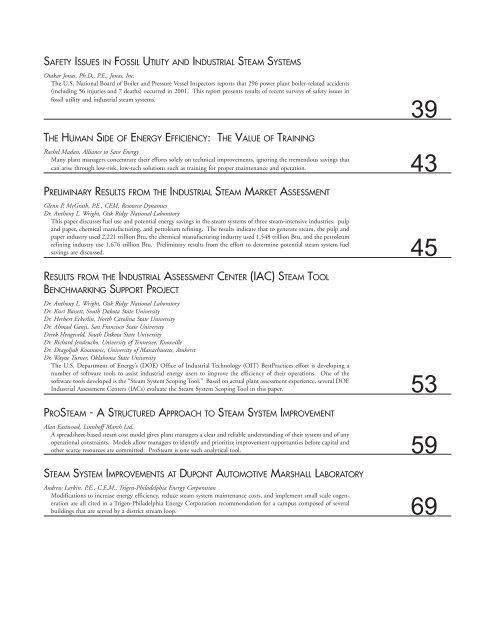Steam Digest 2002 - CiteSeerX
Steam Digest 2002 - CiteSeerX
Steam Digest 2002 - CiteSeerX
You also want an ePaper? Increase the reach of your titles
YUMPU automatically turns print PDFs into web optimized ePapers that Google loves.
SAFETY ISSUES IN FOSSIL UTILITY AND INDUSTRIAL STEAM SYSTEMS<br />
Otakar Jonas, Ph.D., P.E., Jonas, Inc.<br />
The U.S. National Board of Boiler and Pressure Vessel Inspectors reports that 296 power plant boiler-related accidents<br />
(including 56 injuries and 7 deaths) occurred in 2001. This report presents results of recent surveys of safety issues in<br />
fossil utility and industrial steam systems.<br />
39<br />
THE HUMAN SIDE OF ENERGY EFFICIENCY: THE VALUE OF TRAINING<br />
Rachel Madan, Alliance to Save Energy<br />
Many plant managers concentrate their efforts solely on technical improvements, ignoring the tremendous savings that<br />
can arise through low-risk, low-tech solutions such as training for proper maintenance and operation. 43<br />
PRELIMINARY RESULTS FROM THE INDUSTRIAL STEAM MARKET ASSESSMENT<br />
Glenn P. McGrath, P.E., CEM, Resource Dynamics<br />
Dr. Anthony L. Wright, Oak Ridge National Laboratory<br />
This paper discusses fuel use and potential energy savings in the steam systems of three steam-intensive industries: pulp<br />
and paper, chemical manufacturing, and petroleum refining. The results indicate that to generate steam, the pulp and<br />
paper industry used 2,221 trillion Btu, the chemical manufacturing industry used 1,548 trillion Btu, and the petroleum<br />
refining industry use 1,676 trillion Btu. Preliminary results from the effort to determine potential steam system fuel<br />
savings are discussed. 45<br />
RESULTS FROM THE INDUSTRIAL ASSESSMENT CENTER (IAC) STEAM TOOL<br />
BENCHMARKING SUPPORT PROJECT<br />
Dr. Anthony L. Wright, Oak Ridge National Laboratory<br />
Dr. Kurt Bassett, South Dakota State University<br />
Dr. Herbert Eckerlin, North Carolina State University<br />
Dr. Ahmad Ganji, San Francisco State University<br />
Derek Hengeveld, South Dakota State University<br />
Dr. Richard Jendrucko, University of Tennessee, Knoxville<br />
Dr. Dragoljub Kosanovic, University of Massachusetts, Amherst<br />
Dr. Wayne Turner, Oklahoma State University<br />
The U.S. Department of Energy’s (DOE) Office of Industrial Technology (OIT) BestPractices effort is developing a<br />
number of software tools to assist industrial energy users to improve the efficiency of their operations. One of the<br />
software tools developed is the “<strong>Steam</strong> System Scoping Tool.” Based on actual plant assessment experience, several DOE<br />
Industrial Assessment Centers (IACs) evaluate the <strong>Steam</strong> System Scoping Tool in this paper. 53<br />
PROSTEAM - A STRUCTURED APPROACH TO STEAM SYSTEM IMPROVEMENT<br />
Alan Eastwood, Linnhoff March Ltd.<br />
A spreadsheet-based steam cost model gives plant managers a clear and reliable understanding of their system and of any<br />
operational constraints. Models allow managers to identify and prioritize improvement opportunties before capital and<br />
other scarce resources are committed. Pro<strong>Steam</strong> is one such analytical tool. 59<br />
STEAM SYSTEM IMPROVEMENTS AT DUPONT AUTOMOTIVE MARSHALL LABORATORY<br />
Andrew Larkin, P.E., C.E.M., Trigen-Philadelphia Energy Corporation<br />
Modifications to increase energy efficiency, reduce steam system maintenance costs, and implement small scale cogeneration<br />
are all cited in a Trigen-Philadelphia Energy Corporation recommendation for a campus composed of several<br />
buildings that are served by a district stream loop. 69
















